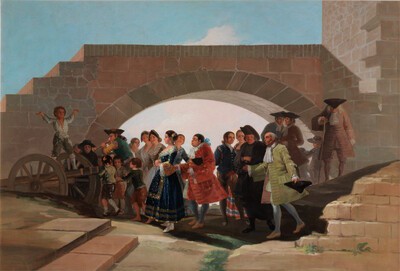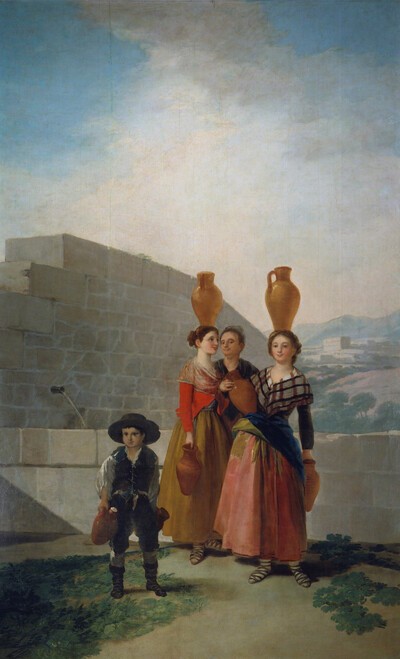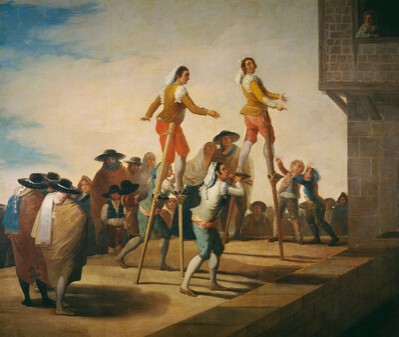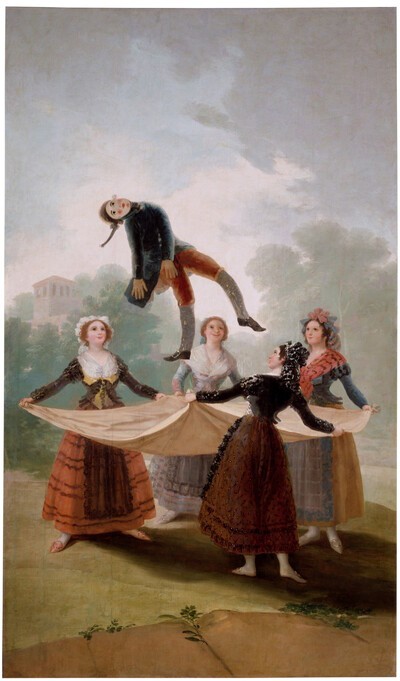- Cronología
- 1791 - 1792
- Ubicación
- The Prado National Museum. Madrid, Madrid, Spain
- Dimensiones
- 137 x 104 cm
- Técnica y soporte
- Oil on canvas
- Reconocimiento de la autoría de Goya
- Documented work
- Titular
- El Prado National Museum
- Ficha: realización/revisión
- 27 Dec 2009 / 14 Jun 2023
- Inventario
- (P07112)
See The Wedding.
Around 1856 or 1857, this cartoon was taken from the Royal Tapestry Factory to the Royal Palace in Madrid. In 1870 the tapestry cartoons that were in the basements of the palace were moved to the Prado Museum, back then known as the Painting and Sculpture Museum. It was then that six cartoons by Goya were discovered to be missing, including the one before us (see Children with a Cart). In 1913 this work was identified in a sale taking place in Paris, at the Galerie Marczell von Nemes. It was acquired by Baron Herzog, who gave it as a gift to Alphonso XIII, who in turn donated it to the Prado Museum, where it remains to this day.
The canvas shows some boys playing at climbing up on each other's shoulders. There are four children and one additional figure. The arrangement of the characters on the canvas follows the same pattern as in previous cartoons such as The Parasol, that is to say, a foreground with figures, a mound behind them, and more figures behind this obstacle, helping to create a sense of depth. A rural landscape occupies the background.
The balancing act of the children reminds the scholar Tomlinson of the moments of political instability that Spain was suffering following the French Revolution and its resulting oppression. Goya's contact with intellectuals did not go unnoticed in his works, and as such the heights to which these boys and the characters of other cartoons in the series climb only serve to remind us of the great fall that awaits them.
-
GoyaKoninklijk Kabinet van Schilderijen MauritshuisThe Hauge1970organized by Ministerio de Estado y Asuntos Culturales and Réunion des Musées Nationaux, July 4th to September 13th 1970. Exhibited also at the Musée de l’Orangerie des Tuileries, Paris, October 25th to December 7th 1970, consultant editors Jeannine Baticle and A. B. de Vriescat. 12
-
Exposición de pintura española del Renacimiento a nuestros díasTokyo1976exhibited also in Hiogo and Kitayushucat. 14
-
GoyaPalacio de PedralbesBarcelona1977from April 12th to June 30th 1977cat. 15
-
Pintura española de bodegones y floreros de 1600 a GoyaMuseo Nacional del PradoMadrid1983consultant editor Alfonso E. Pérez Sánchez, November 1983 to January 1984cat. 41
-
GoyaLa Lonja, Torreón Fortea y Museo Pablo GargalloZaragoza1992consultant editor Julián Gállegocat. 21
-
GoyaNationalmuseumStockholm1994consultant editors Juan J. Luna and Görel Cavalli-Björkman. From October 7th 1994 to January 8th 1995cat. 15
-
Goya. 250 AniversarioMuseo Nacional del PradoMadrid1996consultant editor Juan J. Luna. From March 29th to June 2nd 1996cat. 56
-
Goya: Order and disorderMuseum of Fine ArtsBoston2014cat. 232
-
L'œuvre peint de Goya. 4 volsParís1928-1950vol. I, p. 98, cat. 39
-
Tapices de GoyaMadridPatrimonio Nacional1946pp. 150, 170, 279, cat. 63 y lám. 193
-
Vie et ouvre de Francisco de GoyaParísOffice du livre1970pp. 100, 374, cat. 304
-
BarcelonaPolígrafa1970vol. I, p. 283, cat. 304
-
L’opera pittorica completa di GoyaMilanRizzoli1974p. 105, cat. 260
-
Francisco de Goya, 4 vols.ZaragozaCaja de Ahorros de Zaragoza, Aragón y Rioja1980-1982vol. II, p. 91 y p. 61 (il.)
-
Francisco de Goya, cartones y tapicescol. col. "Espasa Arte"Espasa Calpe1987pp. 61, 170, 320, cat. 68C
-
Francisco de Goya. Los cartones para tapices y los comienzos de su carrera en la corte de Madridcol. col. "Ensayos de Arte Cátedra"MadridCátedra1987pp. 244, 249, 250 y p. 246 (il.)
-
Goya. 250 AniversarioMadridMuseo del Prado1996p. 337, cat. 56 y p. 142 (il.)
-
Goya en Madrid. Cartones para tapices 1775-1794MadridMuseo Nacional del Prado2014p. 217
-
Goya: Order & DisorderBostonMuseum of Fine Arts Boston Publications2014pp. 334-335






